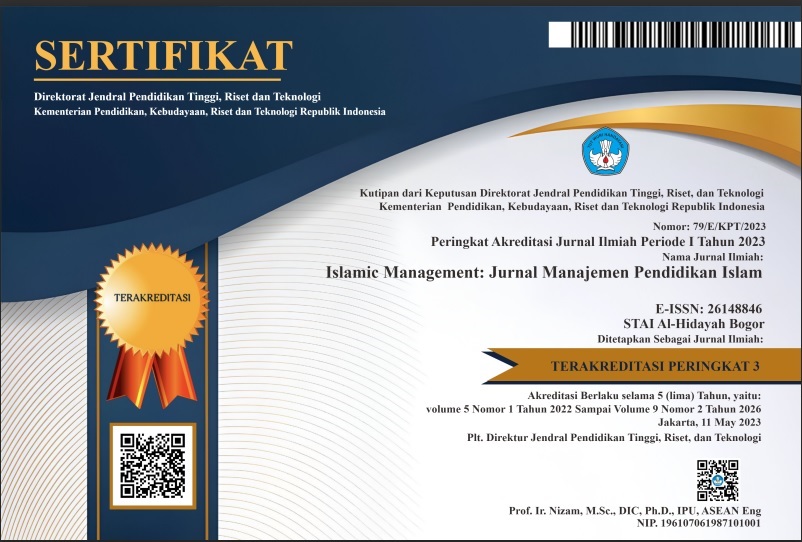TRANSFORMATION OF CAFETERIA SERVICES THROUGH CASHLESS TRANSACTIONS AT IMBOS ISLAMIC BOARDING SCHOOL PRINGSEWU LAMPUNG
DOI:
https://doi.org/10.30868/im.v8i02.8239Keywords:
Cashless transactions, financial digitization, pesantren canteen, service efficiency, financial transparencyAbstract
The development of digital technology has encouraged various sectors, including education, to adopt cashless transaction systems to improve financial efficiency and transparency. This research aims to analyze the transformation of canteen services through the implementation of a cashless transaction system at Pondok Pesantren IMBOS Pringsewu. The research method used is a qualitative approach with a case study design. Data were collected through observation, interviews, and analysis of related documents. The research results show that the implementation of a cashless transaction system based on digital student cards has a significant positive impact. Transaction efficiency increased with faster service times, shorter queues, and more accurate financial record-keeping. This system also allows students to be more independent in managing their finances. However, there are several challenges in its implementation, such as limited internet access, limited transaction devices at each tenant, and resistance from some students and canteen managers who are still accustomed to the cash system. To address these challenges, strengthening digital infrastructure, providing adequate transaction tools, and enhancing digital literacy for students and canteen managers are necessary. Overall, the implementation of cashless transactions at the IMBOS Pringsewu Islamic Boarding School canteen contributes positively to supporting service efficiency and financial transparency, and serves as a model for other boarding schools in adopting a financial digitalization system.
References
Adiyanti,ArsitaIka. (2015). “Pengaruh Pendapatan,Manfaat, Kemudahan Penggunaan, Daya Tarik Promosi, dan Kepercayaan Terhadap Minat Menggunakan Layanan E-Money”. (Studi Kasus: Mahasiswa Universitas Brawijaya).
Bank Indonesia. (2023). Laporan Tahunan Bank Indonesia: Perkembangan Transaksi Digital di Indonesia. Jakarta: Bank Indonesia.
Bank Indonesia Institute. (2023). https://www.bi.go.id/id/bi-institute/BI-Epsilon/Pages/Dompet-Digital--Naik-Daun,-Membetot-Minat-Kala-Pandemi.aspx [Diakses, 12 Februari 2025)
Bogdan, R., & Biklen, S. K. (2007). Qualitative Research for Education: An Introduction to Theories and Methods (5th ed.). Pearson.
Budiyanto, M., & Machali, I. (2014). Pembentukan Karakter Mandiri Melalui Pendidikan Agriculture Di Pondok Pesantren Islamic Studies Center Aswaja Lintang Songo Piyungan Bantul Yogyakarta. Jurnal Pendidikan Karakter, 4(2).
Fauzan, R., & Rahmawati, L. (2022). Digitalisasi Pembayaran dalam Meningkatkan Efisiensi Operasional Kantin Sekolah dan Pesantren. Jurnal Manajemen Keuangan, 10(1), 88-102.
Fitri, S. (2020). Pelatihan Pengelolaan E-Commerce pada Yayasan Pondok Pesantren Al-Hikmah Mangunreja Kabupaten Tasikmalaya. Jurnal Pengabdian Kepada Masyarakat, 273-279
Hastuti, M., & Suhadak. (2019). Analisis Pengaruh Gnnt (Gerakan Nasional Non Tunai) Terhadap Nilai Transaksi Nasabah Dan Dampaknya Terhadap Makroekonomi Indonesia. Jurnal Administrasi Bisnis, 70(1).
Hermawan, R. (2021). Manajemen Layanan Kantin Sekolah: Studi Kasus pada Sistem Transaksi Manual. Yogyakarta: Penerbit Andi.
Hidayat, A., Maulana, F., & Sari, N. (2021). Analisis Stabilitas Jaringan terhadap Efektivitas Sistem Pembayaran Digital di Lingkungan Pendidikan. Jurnal Teknologi Informasi, 5(3), 203-215.
Huda, R., et al. (2023). Digitalisasi Transaksi di Pesantren: Tantangan dan Peluang. Jurnal Ekonomi Syariah, 15(2).
Maulana, A. (2020). Pendidikan Karakter di Lingkungan Pesantren: Konsep dan Implementasi. Bandung: Pustaka Pesantren.
Maulana, A. (2021). Digitalisasi di Lingkungan Pesantren: Tantangan dan Peluang. Bandung: Pustaka Pesantren.
Maulana, D. (2022). Efisiensi Sistem QRIS dalam Meningkatkan Kecepatan Transaksi di Lembaga Pendidikan. Jurnal Teknologi Finansial, 7(3).
Rahayu, N. (2022). Transformasi Digital di Lembaga Pendidikan Islam: Peluang dan Tantangan. Jakarta: Pustaka Islam Nusantara.
Rizal, A. (2021). Manajemen Keuangan Digital dalam Usaha Mikro: Studi Kasus di Koperasi Pesantren. Jurnal Manajemen Keuangan, 10(1).
Syahputra, H., & Haryanto, B. (2022). Peran Bank dalam Mendukung Sistem Pembayaran Digital di Institusi Pendidikan Islam. Jurnal Ekonomi Islam, 15(3), 210-225.
Syahroni, A. W., & Ubaidi. (2018a). Perancangan Aplikasi E-Money dan SMS Gateway untuk Pondok Pesantren di Daerah Madura. Jurnal LINK, 27(1).
Wahyuni, T. (2019). Pengelolaan Kantin Sehat di Sekolah dan Pesantren. Surabaya: Universitas Negeri Surabaya Press.
Wahyuni, T. (2020). Implementasi Teknologi di Lembaga Pendidikan: Studi Kasus pada Sekolah dan Pesantren. Surabaya: Universitas Negeri Surabaya Press.
Yin, R. K. (2018). Case Study Research and Applications: Design and Methods (6th ed.). SAGE Publications.
Downloads
Published
How to Cite
Issue
Section
Citation Check
License
Copyright (c) 2025 Ahmad Nur Huda, Heni Noviarita

This work is licensed under a Creative Commons Attribution-ShareAlike 4.0 International License.
Authors who publish with this journal agree to the following terms:
- Authors retain copyright and grant the journal right of first publication with the work simultaneously licensed under a Creative Commons Attribution License that allows others to share the work with an acknowledgment of the work's authorship and initial publication in this journal.
- Authors are able to enter into separate, additional contractual arrangements for the non-exclusive distribution of the journal's published version of the work (e.g., post it to an institutional repository or publish it in a book), with an acknowledgment of its initial publication in this journal.
- Authors are permitted and encouraged to post their work online (e.g., in institutional repositories or on their website) prior to and during the submission process, as it can lead to productive exchanges, as well as earlier and greater citation of published work (See The Effect of Open Access).






